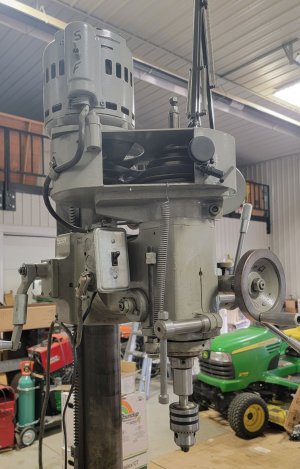Back when I was looking for a good knee mill, I posted a few things about my old mill drill.
It's a bench top round post model with no real z axis other than the quill. The head can be cranked up and down a fair bit to gain working space but totally loses x&y in the process so fairly useless for in-process milling.
I've actually done a fair bit of work with it over the years and it came with some pretty cool MT3 tooling that I will probably sell in order to get R8 equivalents. It has a crude but very functional power x feed, and a really nice 8.5x36 table with odd-ball 1/2" slots for 1/2" nuts and Bolts. No, that's not a brain fart. Normally, you would see 5/8 slots with 1/2" Bolts. This one really is half and half!
As discussed during my mill search, it's biggest problem is the flaky x/y axis graduations on the leade screws. The crank wheels have 22 graduations on them marked as 0 1, 2, 3, 4, 5, 6, 7, 8, 9, and 10, then starting over at 0. Yes, you read that correctly. There really is both a 10 and a zero. As a result, each turn of the crank is 110 thou, not 100.

It's not exactly 110 though, I believe it's actually 111.111111. And in truth, using a dial indicator on the table, the numbers do grow by just over a thou per revolution.
In the previous thread on finding a decent mill, forum members speculated that the mill might have been metric once upon a time. But I don't think so.
I measured the two lead screws very carefully. They are both regular 60° threads on a 7/8 rod. And it just so happens that the normal course thread for a 7/8 bolt is 9 tpi. And 9tpi is exactly.. 0.1111... pitch between threads.
So that mystery is solved. The leade screws are 7/8-9 regular 60° thread and they are probably just plain old ready rod.
In order to sell the mill drill with some integrity, I feel like I pretty much have to replace the leade screws with proper ACME screws in SAE 10tpi or 2mm Metric. If I can't find the right combo of screws and nuts, I'll make them. It's either that or outright give it away.
If anyone has any advice on how to go about all the above, or things you don't agree with, I'd love to hear about it.
The other thing is a proper ID on the mill/drill (make, model, etc) or even where to find that info. That would be much appreciated. Here are some photos.
Anybody recognize the old girl? Or even her bones.

It's a bench top round post model with no real z axis other than the quill. The head can be cranked up and down a fair bit to gain working space but totally loses x&y in the process so fairly useless for in-process milling.
I've actually done a fair bit of work with it over the years and it came with some pretty cool MT3 tooling that I will probably sell in order to get R8 equivalents. It has a crude but very functional power x feed, and a really nice 8.5x36 table with odd-ball 1/2" slots for 1/2" nuts and Bolts. No, that's not a brain fart. Normally, you would see 5/8 slots with 1/2" Bolts. This one really is half and half!
As discussed during my mill search, it's biggest problem is the flaky x/y axis graduations on the leade screws. The crank wheels have 22 graduations on them marked as 0 1, 2, 3, 4, 5, 6, 7, 8, 9, and 10, then starting over at 0. Yes, you read that correctly. There really is both a 10 and a zero. As a result, each turn of the crank is 110 thou, not 100.
It's not exactly 110 though, I believe it's actually 111.111111. And in truth, using a dial indicator on the table, the numbers do grow by just over a thou per revolution.
In the previous thread on finding a decent mill, forum members speculated that the mill might have been metric once upon a time. But I don't think so.
I measured the two lead screws very carefully. They are both regular 60° threads on a 7/8 rod. And it just so happens that the normal course thread for a 7/8 bolt is 9 tpi. And 9tpi is exactly.. 0.1111... pitch between threads.
So that mystery is solved. The leade screws are 7/8-9 regular 60° thread and they are probably just plain old ready rod.
In order to sell the mill drill with some integrity, I feel like I pretty much have to replace the leade screws with proper ACME screws in SAE 10tpi or 2mm Metric. If I can't find the right combo of screws and nuts, I'll make them. It's either that or outright give it away.
If anyone has any advice on how to go about all the above, or things you don't agree with, I'd love to hear about it.
The other thing is a proper ID on the mill/drill (make, model, etc) or even where to find that info. That would be much appreciated. Here are some photos.
Anybody recognize the old girl? Or even her bones.
Attachments
Last edited:

